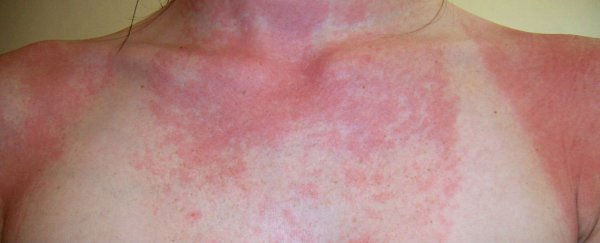Without the Sun, there would be no life on our planet - and yet for some, this giant ball of hot plasma makes life rather difficult. There are people who develop a rash or even break out into painful, itchy hives if they get exposed to sunlight. While the folk term for this problem is called sun allergy, these symptoms can actually be triggered by several distinct conditions, which, technically speaking, are not always allergies.
The most common sun-related skin problem - affecting roughly 10 percent of the population - is called polymorphous light eruption (PLE). Shortly after exposure to sunlight a person's skin around the chest and arms becomes red and itchy, and it can take up to a week for the symptoms to resolve. It's most common in Caucasian women with fair skin who live in the northern parts of the northern hemisphere.
What's interesting is that PLE tends to flare up in spring and early summer, when people first start getting out in the sunlight. As exposure increases throughout the sunny weather, symptoms ease up - but then disappointingly return the next year. Scientists are not entirely sure why PLE develops, but it seems to be a sensitivity to ultraviolet radiation - the short wavelength of sunlight that reaches our planet.
A more dramatic 'sun allergy' produces not just a rash, but large hives on sun-exposed skin - this super-rare condition is called solar urticaria. It can be quite painful to deal with, as an outbreak will start with itching and then develop into big welts. If a large enough area of the skin is exposed and develops the reaction, a person can even go into anaphylactic shock. Sunbathing is the stuff of horrors for people afflicted with this condition.
Solar urticaria is mediated by immunoglobulin E (IgE) - the same antibody that plays a role in various allergies, including pollen, food sensitivities, asthma, and others. Hence treatment includes taking antihistamines to deal with the allergic response in the body, as well as a steroid cream to treat the skin itself.
Yet another type of sun sensitivity is called actinic prurigo, and predominantly affects people of American Indian and Latin American descent, especially in Mexico and Central America. This largely genetic condition is characterised by an intensely itchy rash that develops on sun-exposed areas of the skin, including the face and lips. There's no cure, and the most typical medical advice is to avoid sunlight as much as possible, along with the usual topical steroid creams to deal with the rash.
Even if you're genetically spared from all of these conditions, sunlight sensitivity can still happen to you - thanks to certain medications or topical creams. Doxycycline, a common acne medication, is one such drug, but other antibiotics such as sulfonamides can also cause it. Non-steroidal anti-inflammatory drugs (NSAIDs), such as ibuprofen or naproxen, are also known to create photosensitivity, as are some birth control pills, high blood pressure meds, and others.
A sunlight-induced rash is definitely bothersome to deal with, but unlike some other allergies (looking at you, peanuts) at least it's highly unlikely you'll end up dying from anaphylaxis. So… always look on the bright side?
